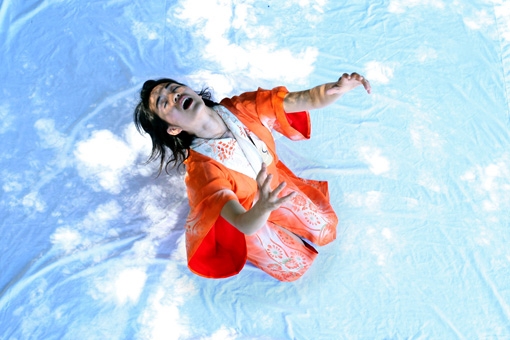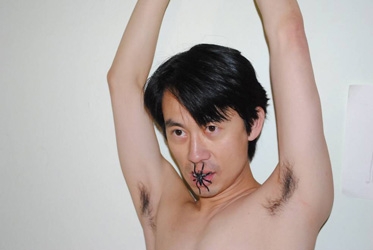Tita Aida. Photo by Danny Dan.
When Yvette Choy and Alicia Ohs describe Ms. TangTang, they say that she is a “mix between RuPaul and Oprah but Asian American.” Ms. TangTang is the central character in Choy and Ohs’s latest project, The Ms. TangTang Show, a mock talk show in which a rapid-firing diva of a talk show host interviews and showcases queer Asian American dancers, musicians, performers, spoken-word artists, and filmmakers. The show, which is sponsored by Hyphen, is a co-presentation of 2011 National Queer Arts Festival and the API Cultural Center's 14th Annual United States of Asian America Festival and premieres on Thursday, June 23 at San Francisco’s Buriel Clay Theater.
Choy, a filmmaker, and Ohs, who works in theater and dance, are long time collaborators who both attended NYU’s Tisch School of the Arts. The pair has developed such inventive projects as Spontaneous Combustion!, in which a group of interdisciplinary artists gathered for 12 hours in order to create an original performance piece, and when i die i will be dead, which combined video installation, audience participation, and dance to explore locations and themes such as the competitive New York dance world and grief and mourning.

Alicia Ohs in when i die i will be dead. Photo by Erin Siegal
Last year, Choy and Ohs applied and received a grant from the Queer Cultural Center to create and develop The Ms. TangTang Show. Initially, the idea for the show sprang out of what Choy and Ohs saw as the invisibility of queer Asian American performers. “We decided we wanted to see more Asian Americans in performance, which we felt was lacking in our community,” says Choy. Ms. TangTang began to take shape as a talk show that would present a series of queer Asian American performers. It would be loosely scripted, with Ms. TangTang operating as the central, lively figure introducing each artist and entertaining the audience with improvisational talk.
However, Choy and Ohs soon reached a stumbling block in assembling a line-up of queer Asian American performers:
“We only knew each other and Philip Huang,” says Choy.
Subsequently, Choy and Ohs put out an open call for performers and received few responses. In these beginning stages of the project, Ohs and Choy had a difficult time searching for artists who identified as queer Asian American performers and artists. Choy says that it was challenging to “even [think of] queer Asian Americans. Period.”
“It was strange that we had to think so hard to come up with names,” Choy says. “Once we started to search, it was amazing.”
Ohs and Choy say that this process of seeking out queer Asian American artists became easier as result of community contacts, of one artist putting them in touch with another artist. While initially a queer Asian American artist community seemed relatively small and invisible to Choy and Ohs, their efforts to cast Ms. TangTang resulted in a surprising unearthing of a community that the pair did not realize already existed in pockets across the nation as well as internationally.
In their hunt for performers, Ohs says that they did not want to “codify [queer Asian American art].” Instead, Ms. TangTang’s showing of a wide spectrum of artists was purposed to enlarge and expand notions of queer Asian American art rather than pigeonholing or simplifying it.
The multi-textured nature of the show is evidenced by the performers, who each defy easy categorizations and inhabit a vast range of gender, sexual, and disciplinary identities. The San Francisco-based transwoman-performer, Tita Aida will take on the role of the titular character. Choy says that Aida’s character is “gender bending and [has] that flexibility and the androgyny of being Asian.” Other artists include: the imaginative and outrageous Philip Huang (whose work includes videotaping himself holding up a sign that states “No Fags on the Moon” at an anti-gay rally), the Sri-Lankan spoken word artist/comedian/rapper and frequent Mr. Hyphen emcee D’Lo, and photographer Mia Nakano, whose latest project includes taking portraits of queer Asian Americans who were at one time female-identified. [Nakano was also a founding member of Hyphen, serving as Photo Editor and now as a contributing photographer].

Philip Huang. Photo from Queer Cultural Center
The line-up of Ms. TangTang embodies a connection and bridging together of a potent, lively queer Asian American community. As the show is happening on the Thursday before San Francisco’s immense Gay Pride Festival, Ohs says that it is also “a culmination of energy from this larger community [that] exists in separate communities.” Additionally, while the artists themselves come from a range of geographical locals and experiences, Ms. TangTang represents an “event for them to be able to be in the same room together, perform together, talk about their art.”
On the reaction from both the queer and Asian American communities, Choy says, “They’re just like, ‘It’s about time.’”
“It’s such a spark. A fireball,” Choy says.
What: The Ms. TangTang Show
Who: Ms. TangTang will be played by Tita Aida. Guest artists include: D’Lo, Jai Arun Ravine, Kit Yan, Mia Nakano, Philip Huang, SKIM, The Rice Rockettes and more.
When: June 23, 2011, 7:30pm
Where: African American Art and Culture Complex, Buriel Clay Theater, 762 Fulton Street, San Francisco, CA
Tickets: http://www.brownpapertickets.com/event/174190 $15 - $20
More Information: www.queerculturalcenter.org/www.mstangtang.com
Help fund The Ms.TangTang Show at: http://www.kickstarter.com/projects/741246067/the-ms-tangtang-show









Comments